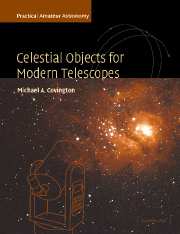Book contents
- Frontmatter
- Contents
- Preface
- Part I Amateur astronomy
- 1 Using this book effectively
- 2 Observing sites and conditions
- 3 The Moon, the Sun, and eclipses
- 4 The planets
- 5 Comets, asteroids (minor planets), and artificial satellites
- 6 Constellations
- 7 Stars – identification, nomenclature, and maps
- 8 Stars – physical properties
- 9 Double and multiple stars
- 10 Variable stars
- 11 Clusters, nebulae, and galaxies
- Part II 200 interesting stars and deep-sky objects
- Appendices
- Index
8 - Stars – physical properties
Published online by Cambridge University Press: 22 September 2009
- Frontmatter
- Contents
- Preface
- Part I Amateur astronomy
- 1 Using this book effectively
- 2 Observing sites and conditions
- 3 The Moon, the Sun, and eclipses
- 4 The planets
- 5 Comets, asteroids (minor planets), and artificial satellites
- 6 Constellations
- 7 Stars – identification, nomenclature, and maps
- 8 Stars – physical properties
- 9 Double and multiple stars
- 10 Variable stars
- 11 Clusters, nebulae, and galaxies
- Part II 200 interesting stars and deep-sky objects
- Appendices
- Index
Summary
Magnitude
The magnitude system
The magnitude of a star is its brightness measured in a somewhat peculiar way. In ancient times, Ptolemy and Hipparchos classified stars as “first class” (brightest) to “sixth class” (barely visible). These brightness classes were termed magnitudes, but there was no provision for exact measurement.
In 1856, Norman Pogson proposed the logarithmic magnitude scale that is now standard. The advantage of a logarithmic scale is that it can span a tremendous brightness range without using very large or very small numbers (Figure 8.1). Each difference of five magnitudes corresponds to a factor-of-100 difference in brightness. One magnitude corresponds to a brightness ratio of 2.512.
In this system, most stars still have roughly the magnitude that Ptolemy assigned them, but some of the brightest stars have negative magnitudes. The full moon is magnitude – 12 and the Sun is –27. This 15-magnitude difference means that the Sun is a million times as bright as the Moon.
The star Vega is defined to be magnitude 0.0, but in practice, the average of several stars is used as a standard for measurement.
The human eye's response to light is not actually logarithmic, but it is close enough for practical purposes. If a star appears to be halfway between two other stars in brightness, it will also be halfway between them in magnitude.
- Type
- Chapter
- Information
- Celestial Objects for Modern TelescopesPractical Amateur Astronomy Volume 2, pp. 112 - 122Publisher: Cambridge University PressPrint publication year: 2002

